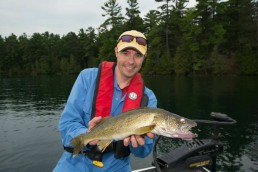How to Avoid Common Canadian Walleye Pitfalls
Let’s explore a few pitfalls many of us have fallen prey to at one point or another when pursuing walleyes, or pickerel, as we sometimes call them in Canada. Learning to avoid these stumbling blocks is one way to improve and refine your skills.
Learn to love dawn
“Well lads, it’s hard to soar early with the eagles if you want to hoot late with the owls.”
These were the words of a friend’s father during a Boy Scout camping trip at breakfast, after I and several other eight-year-olds clowned around late into the night. This expression has stuck with me, because it applies to fishing. While camaraderie is a big reason we fish with pals, it’s important to get priorities straight. Dawn is one of the best times to target walleyes. Set an alarm and get on the water early. On fishing trips, take a power nap during the day, if you can, to be invigorated for the dusk bite.
Sunny side up ‘eyes
While dawn is productive, it’s not the only time to catch fish. Although walleyes can be tough to catch at midday in high sun because of their preferences for low-light conditions, they can still be fooled into biting.
Many walleyes move deeper during the middle of the day. For example, if you were catching them at the top of a drop-off in 15 feet at dawn, look for them in 20-plus feet in high sun, down at the base of the drop-off. Other good daytime structures are deep humps, reefs, saddles, and bars. Try the shaded sides of these spots first, because walleyes prefer the shadows.
Other daytime strategies include pitching jigs for weed-living walleyes or trolling spinners or hard baits for fish suspending over a lake basin. These two scenarios are distinct from each other, and both are worth exploring. Generally, walleyes in weeds and basins receive less fishing pressure than fish relating to classic structures. Seeking out less-popular populations of walleye boosts the odds of finding willing biters.
Don’t assume finesse first
During my youthful rookie years as an angler, I used finesse tactics to catch walleyes. Power fishing, as it’s known, was an unknown. A 3-inch grub and jighead, a marabou jig tipped with a nightcrawler, and a walking sinker combined with a floating snell and minnow were some of my regular tactics. What I’d give to be able to wind back the clock.
Today, I begin most outings using an aggressive presentation with a sizable bait, like a big-bladed worm harness, a jigging spoon, swimbait, or crankbait. These tactics cover water and produce plenty of fish. If unsuccessful with these methods, I take it to mean that fish are not particularly active. Now it’s time to slow down and wade into finesse tactics. When I began this fish-fast-first approach, I was surprised how frequently walleyes were active, or could be triggered to hit with assertive presentations, in conditions that I’d previously considered to produce tough fishing. Give it a try and see if you experience similar results.
Better bait management
While artificial baits are popular, live bait remains a key component of many walleye presentations. Maintaining healthy bait is a must to maximize bites when fish are fussy. Step one is keeping bait cool. Use ice packs on hot days, and store bait containers in the shade. Step two is frequent water circulation for minnows and leeches or regular worm bedding changes. Step three is getting rid of dead bait that can plague the health of your supply. Follow these steps and your bait will remain fresh and lively, just how walleyes like it.
Careful with cruise control
Trolling is one of the most effective ways to catch walleyes, from big water to little lakes. It’s also relaxing—sometime too much so. Effective trolling is a game of precision. It’s important to stay engaged and remain analytical about your tactics. This includes monitoring trolling speed, interpreting sonar data, and following waypoints or a contour line to position baits in the strike zone.
Trolling as a team is also recommended. Use available lines to experiment with different presentations, lure actions, color, and running depths. Cooperating makes quick work of figuring out a fish-catching pattern.
Stuck in a rut
Most anglers I know have favorite lures and confidence baits. Getting stuck on a particular presentation or location can lead to many wasted hours on the water. Walleyes are highly adaptable predators and can be found in a range of habitats. Versatility, flexibility, and keeping an open mind are important characteristics to have as an angler. Make it a goal to try fishing walleyes with new methods and in different areas than you usually do. Give it a go and you’ll grow as an angler, learn new tactics, and boost the number of walleyes you bring over the boat gunwale in a season.
Walleyes are fun to catch but offer their share of challenges. Sidestep the above pitfalls and you’ll put a lot more marble eyes in the net.
MWO
SHARE THIS POST
Did you enjoy this post?
You can be among the first to get the latest info on where to go, what to use and how to use it!
Tim Allard
Tim Allard is a full-time outdoor journalist and author and photographer of the multi-award-winning book, Ice Fishing––The Ultimate Guide. Follow him on Instagram @timallardtips.



